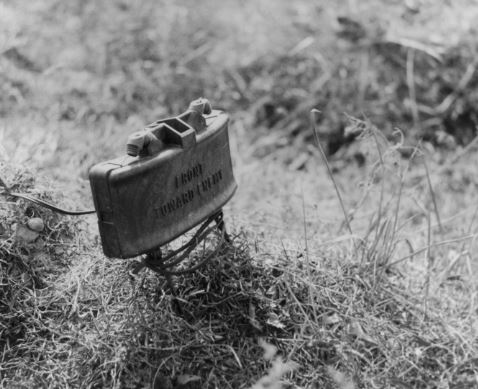By Peter Alan Lloyd
PAL: What was it like being in the jungle at night when you were on your missions?
Forward Air Controller flying over the Laotian jungle (Gary Cantrell). Note the B52 bombing tracks in the jungle beneath the plane

darkness fell?

Cambodian Jungle
Claymore mine, bearing a helpful instruction: ‘Front Towards Enemy


One of Jim’s team members with camouflaged hat on a SOG mission inside Cambodia
Vietnamese Centipede

PAL: What time would you wake up and move out the following day?
PAL: Did you have any memorable incidents with these creatures at night?

A ‘Click Click’ or Stag Beetle
Jim on a mission inside Cambodia: “In this photo I was checking my map to give me an idea of what I wanted to accomplish for the day and planning my route according to the terrain and enemy movement.”


A Cambodian jungle river
PAL: Why was that as mistake?

JB: No. One night, during a RON, right before dark, one of my indigenous personnel brushed a deadly Pit Viper off my pack. We were in heavy bamboo and I would say that I was lucky not to have been bitten. Again the centipedes, ther small snakes and of course the click clicks. but the strangest encounter we had was with a tiger in Cambodia. We had just talked to the FAC and used a mirror so we could communicate with him and pinpoint our position. The reason we could use the mirror was we were in some very tall elephant grass. The grass was tall enough to conceal us easily but the FAC could look down and see us. This would be our last communication for the day.
Tall elephant grass in Vietnam

We were in the process of finding a RON position. The FAC radioed back to us to be careful because he could see there was a big tiger following us through the grass. We couldn’t see or hear it and had no idea it was stalking us at that point. When we found a place bad enough to RON in, my 1-1 and I decided to sit back to back almost the entire night to cover each other just in case. It was a little while after dark when we all heard the tiger. He started walking around our perimeter about 30 feet out. He was actually moaning with a deep low sound.

Large tiger caught prowling in nighttime jungle camera trap
Jim firing the .45 caliber M-3 Silenced Grease Gun that they took on missions, which they put together that night, in case the tiger attacked.





Incredible story. Mr. Bolen, I don’t know how you did it.
This was a great story. I read Jim’s book and he had a wild life. Im happy he made it through all the stuff he did.God Bless all those vietnam war fighters